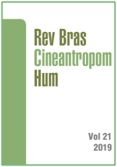Efeitos de curto prazo do treinamento combinado da seleção brasileira de basquetebol feminino
DOI:
https://doi.org/10.1590/1980-0037.2019v21e59839Resumo
As competições são consideradas o elemento central para o desporto de rendimento, pois determinam toda a orientação do processo de treinamento. Ao observar o calendário da Federação Internacional de Basquetebol, percebe-se que as competições internacionais acontecem em curtos períodos de tempo. Neste sentido, o objetivo deste trabalho foi verificar os efeitos da aplicação do treinamento combinado na preparação de curto prazo, sobre a capacidade biomotora velocidade, em atletas adultas da seleção brasileira de basquetebol feminino. Participaram deste estudo 13 atletas da seleção brasileira de basquetebol feminino da categoria adulta, que fizeram parte da preparação para a disputa dos Jogos Pan Americanos em 2015. As atletas foram submetidas a medidas antropométricas e avaliação da capacidade biomotora velocidade cíclica - corrida de 20m, e acíclica - teste T, no início (M0) e ao final de um período de preparação de 27 dias (M1). Considerando o período disponível para treinamento o % da duração total foi de: técnico/tático 73,7%, físico: 5,7%, preventivo: 10,5% e aquecimento geral e especial: 10,1%. Após a coleta dos dados utilizou-se o teste de Shapiro-Wilk para verificar a normalidade e, a seguir, o teste T de Student. Os principais resultados apontam que o melhor tempo para avaliar a velocidade cíclica (M0 e M1, respectivamente), foi de 3,34±0,22s e 3,39±0,21s e, na acíclica (M0 e M1, respectivamente), foi de 9,30±0,49s e 9,52±0,57s. Conclui-se que durante um curto período de intervenção, com grande concentração de estímulos, não foi eficiente para melhorar a capacidade biomotora velocidade cíclica e acíclica.Referências
Silva LO, Campo SS. Características del esfuerzo em competición em jugadoras de baloncesto de elite durante las fases finales de la Euroliga y el Campeonato del Mundo. Rev Int Cienc Deporte 2013, 34 (9): 360-376.
Zwierko T, Lesiakowski P. Selected parameters of speed performance of basketballplayers with different sport experience levels. Stud Phys Culture Tour 2007; 14: 307-312.
Ostojic SM, Mazic S. Profiling in basketball: Physical and physiological characteristics of elite players. J Strength Cond Res 2006; 20(4):740-744.
Moreira A, Oliveira PR. A dinâmica de alteração das medidas de força e o efeito posterior duradouro de treinamento em basquetebolistas submetidos ao sistema de treinamento em bloco. Rev Bras Med Esporte 2004; 10(4):243-250.
Moreira A, Okano AH. Sistema de cargas seletivas no basquetebol durante um mesociclo de preparação: implicações sobre a velocidade e as diferentes manifestações da força. Rev Bras Ciênc Mov 2005;13(3):7-16.
Balciunas M, Stonkus S. Long term effects of different training modalities on power, speed, skill and anaerobic capacity in young male basketball players. J Sports Sci Med 2006;5:163-170.
Beneli LM, Rodrigues EF. Periodização do treinamento desportivo para atletas da categoria infantil masculino de basquetebol. Rev Treinam Desportivo 2006;7(1): 29-35.
Bogdanis GC, Ziagos V. Effects of two different short-term training programs on the physical and technical abilities of adolescent basketball players. J Sci Med Sport 2007;10(2):79-88.
Forteza A. Entrenamiento desportivo: ciência e innovación tecnológica. La Habana:Científico-Técnica; 2001.
Foster C. Monitoring training in athletes with reference to overtraining syndrome. Med Sci Sports Exercise 1998; 30(7):1164-1168.
Borg G. Psychophysical bases of perceived exertion. Med Sci Sports Exec 1982;14(5):377-381.
Eston R, Reilly T. Kinanthropometry and exercise physiology laboratory manual: tests, procedures, and data. Oxon: Routledge, 2009.
Pauole K, Madole K. Reliability e validity of the T-Test as a measure of agility, leg power and leg speed in college-age men and women. J Strength Cond Res 2000; 14(4):443-450.
Cohen J. Statistical power analysis for the behavioral sciences. Hillsdale, New Jersey: Erlbaum, 1988.
Rhea MR. Determining the magnitude of treatment effects in strength training research through the use of the effect size statistic. J Strength Cond Res 2004;18(4):918-920.
Buchheit M, Laursen PB. High-intensity interval training,solutions to the programming puzzle. Part I: cardiopulmonar emphasys. Sports Med 2013; 43(5):313-338.
Reilly T, Bangsbo J. Anthropometric and physiological predispositions for elite soccer. J Sports Sci 2000;18(9):669-683.
Buchheit M, Mendez-Villanueva A. Improving acceleration and repeated sprint ability in well-trained adolescent handball players: speed versus sprint interval training. Int J Sports Phys Performance 2010;5(2):152-164.
Foster C, Florhaug JA, Franklin J, Gottschall L, Hrovatin LA, Parker S, et al. A new approach to monitoring exercise training. J Strength Cond Res 2001;15(1):109–115.
Manzi V, D’ottavio S. Profile of weekly training load in elite male professional basketball players. J Strength Cond Res 2010;24(5):1399-1406.
Downloads
Publicado
Edição
Seção
Licença

Direitos Autorais para artigos publicados nesta revista são do autor, com direitos de primeira publicação para a revista. Em virtude da aparecerem nesta revista de acesso público, os artigos são de uso gratuito, com atribuições próprias, em aplicações educacionais e não-comerciais, desde que seja dada a atribuição. Esta obra foi licenciada com uma Licença Creative Commons Atribuição 4.0 Internacional - CC BY


